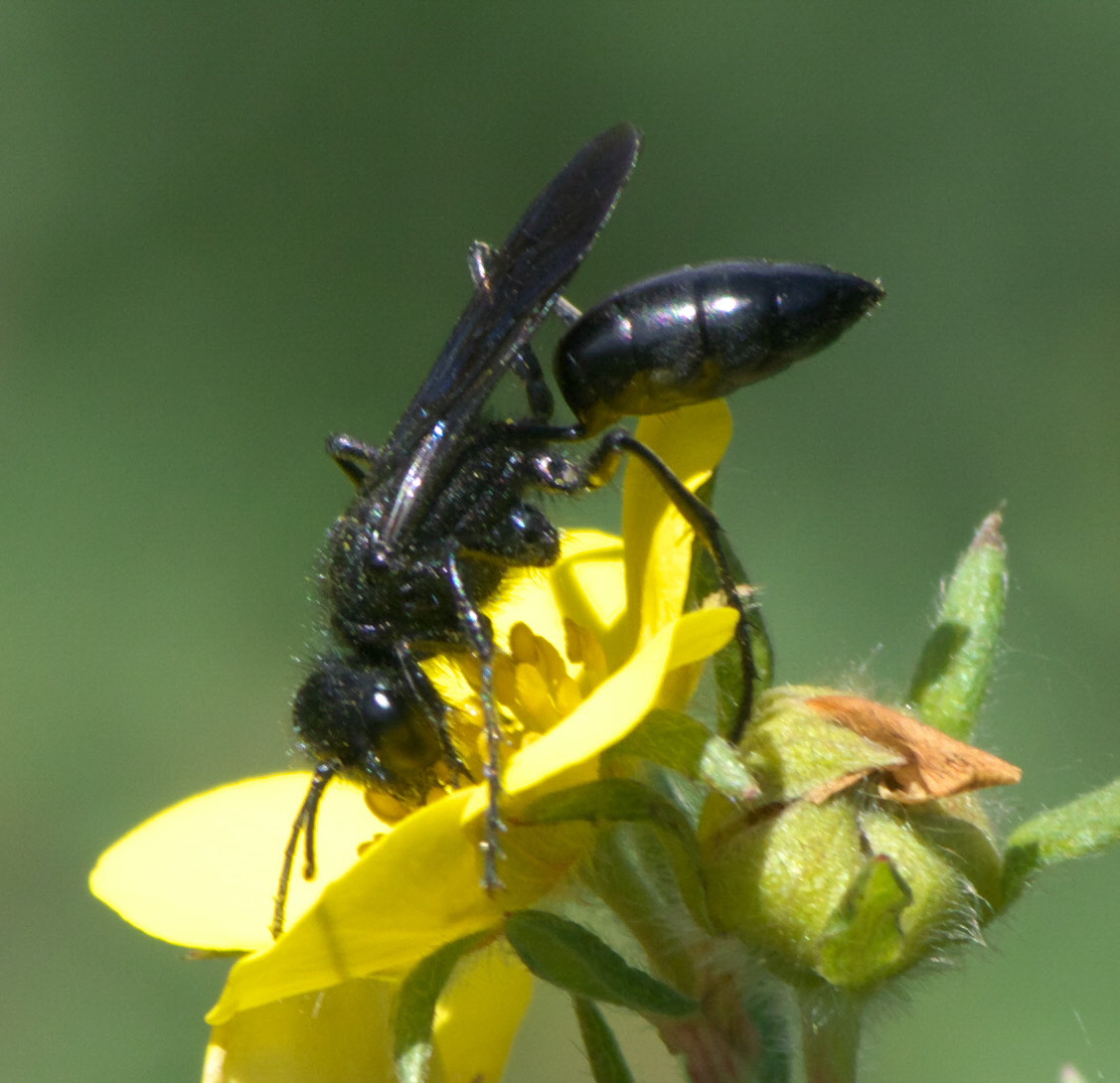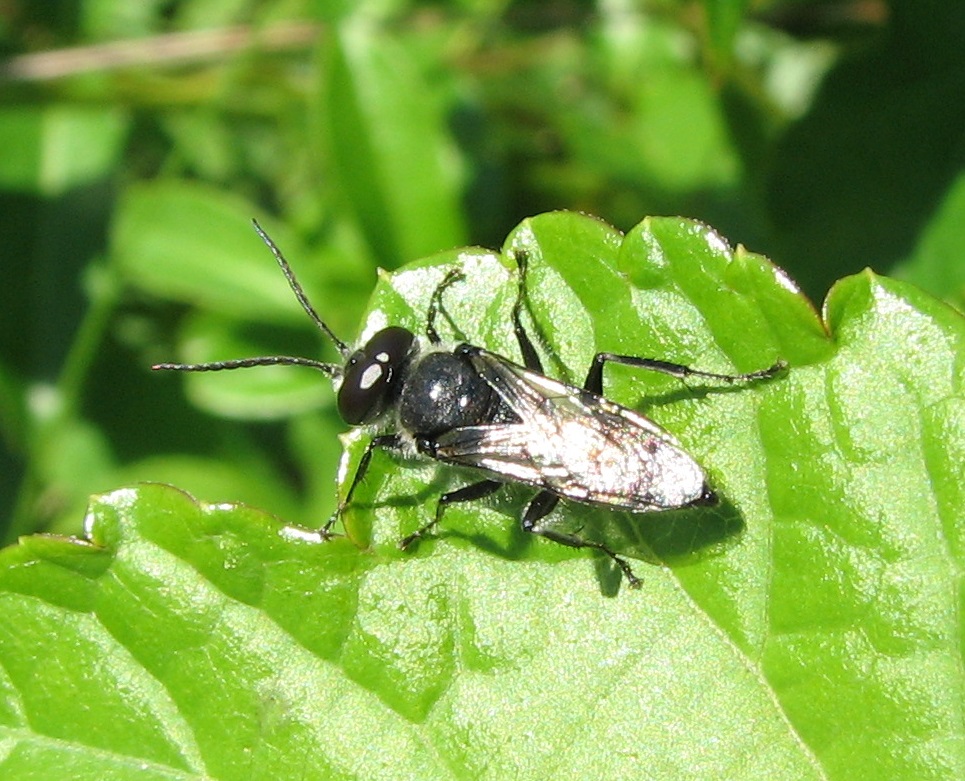|
Sphecidae
The Sphecidae are a Cosmopolitan distribution, cosmopolitan family of wasps of the suborder Apocrita that includes Ammophilinae, sand wasps, mud daubers, and other thread-waisted wasps. The name Sphecidae was formerly given to a much larger grouping of wasps. This was found to be paraphyletic, so most of the old subfamilies have been moved to the Crabronidae. Biology The biology of the Sphecidae, even under the restricted definition, is still fairly diverse; some sceliphrines even display rudimentary forms of sociality, and some sphecines rear multiple larvae in a single large brood cell. Many nest in pre-existing cavities, or dig simple burrows in the soil, but some species construct free-standing nests of mud and even (in one genus) resin. All are predatory and parasitoidal, but the type of prey ranges from spiders to various dictyopterans, orthopteroids and larvae of either Lepidoptera or other Hymenoptera; the vast majority practice mass provisioning, providing all the pr ... [...More Info...] [...Related Items...] OR: [Wikipedia] [Google] [Baidu] |
Crabronidae
The Crabronidae is a large family of wasps within the superfamily Apoidea. Taxonomy and phylogeny This family has historically been treated as a subfamily in the now-defunct Spheciformes group under the family Sphecidae. The Spheciformes included well over 200 genera, containing well over 9000 species. Revision of these taxa resulted resulted in the restriction of the Sphecidae to what was once the subfamily Sphecinae. As a result, the former Crabroninae was elevated to family status as Crabronidae. Subsequent revision has further restricted the Crabronidae. Several of the subfamilies of the Crabronidae are often treated as families in their own right, as is true of the most recent phylogenies. Of these lineages of Apoidea, only three were not included within Crabronidae in the past: Ampulicidae, Sphecidae, and Anthophila. The following phylogenetic tree is based on Sann ''et al.'', 2018, which used phylogenomics to demonstrate that both the bees ( Anthophila) and the Sphe ... [...More Info...] [...Related Items...] OR: [Wikipedia] [Google] [Baidu] |
Mud Dauber
Mud dauber (or "mud wasp") is a name commonly applied to a number of wasps from either the family Sphecidae or Crabronidae which build their nests from mud; this excludes members of the family Vespidae (especially the subfamily Eumeninae), which are instead referred to as "potter wasps". Mud daubers are variable in appearance. Most are long, slender wasps about in length. The name refers to the nests that are made by the female wasps, which consist of mud molded into place by the wasp's Mandible (insect mouthpart), mandibles. Mud daubers are not normally aggressive, but can become belligerent when threatened. Stings are uncommon. Nests The organ pipe mud dauber, one of many mud daubers in the family Crabronidae, builds nests in the shape of a cylindrical tube resembling an organ (music), organ pipe or pan flute. Common sites include vertical or horizontal faces of walls, cliffs, bridges, overhangs and shelter caves or other structures. The nest of a black and yellow mud daube ... [...More Info...] [...Related Items...] OR: [Wikipedia] [Google] [Baidu] |
Ammophilinae
Ammophilinae is a subfamily of thread-waisted wasps in the family Sphecidae The Sphecidae are a Cosmopolitan distribution, cosmopolitan family of wasps of the suborder Apocrita that includes Ammophilinae, sand wasps, mud daubers, and other thread-waisted wasps. The name Sphecidae was formerly given to a much larger g .... There are about 6 genera and more than 320 described species in Ammophilinae. Genera These six genera belong to the subfamily Ammophilinae: * '' Ammophila'' W. Kirby, 1798 * '' Eremnophila'' Menke, 1964 * '' Eremochares'' Gribodo, 1883 * '' Hoplammophila'' de Beaumont, 1960 * '' Parapsammophila'' Taschenberg, 1869 * '' Podalonia'' Fernald, 1927 (cutworm wasps) References External links * Sphecidae Apocrita subfamilies {{apoidea-stub ... [...More Info...] [...Related Items...] OR: [Wikipedia] [Google] [Baidu] |
Podalonia P1520025a
''Podalonia'' is a genus of parasitoidal wasps in the family Sphecidae. The genus is present worldwide with the exception of South America. These wasps are similar to the related sand wasp genus, '' Ammophila'', but they have a much shorter petiole, and the abdomen is slightly stronger. The females lay their nests in the sand. They normally incubate in large, hairless caterpillars of moths in the family Noctuidae. Species This genus includes 67 described species A species () is often defined as the largest group of organisms in which any two individuals of the appropriate sexes or mating types can produce fertile offspring, typically by sexual reproduction. It is the basic unit of Taxonomy (biology), ...: *'' Podalonia affinis'' (W. Kirby, 1798) *'' Podalonia afghanica'' Balthasar, 1957 *'' Podalonia albohirsuta'' (Tsuneki, 1971) *'' Podalonia alpina'' (Kohl, 1888) *'' Podalonia altaiensis'' (Tsuneki, 1971) *'' Podalonia andrei'' (F. Morawitz, 1889) *'' Podalon ... [...More Info...] [...Related Items...] OR: [Wikipedia] [Google] [Baidu] |
Isodontia Larva
''Isodontia'' is a genus belonging to the family Sphecidae. Adults emerge from their cocoons in early summer, and usually make nests lined with grass or hay in hollow plant cavities. This has led to their common name being grass-carrying wasps. The larvae are often fed Orthoptera that the adult has paralyzed. Species Species within this genus include: * '' Isodontia albata'' * '' Isodontia alvarengai'' * '' Isodontia apicalis'' * '' Isodontia apicata'' * '' Isodontia aurifrons'' * '' Isodontia auripes'' * '' Isodontia auripygata'' * '' Isodontia azteca'' * '' Isodontia bastiniana'' * '' Isodontia boninensis'' * ''Isodontia bruneri'' * '' Isodontia capillata'' * ''Isodontia cellicula'' * '' Isodontia cestra'' * '' Isodontia chrysorrhoea'' * '' Isodontia costipennis'' * ''Isodontia cyanipennis'' * ''Isodontia delicata'' * ''Isodontia diodon'' * ''Isodontia dolosa'' * ''Isodontia edax'' * ''Isodontia egens'' * ''Isodontia elegans'' * ''Isodontia elsei'' * ''Isodontia exornata'' * ... [...More Info...] [...Related Items...] OR: [Wikipedia] [Google] [Baidu] |
Apocrita
Apocrita is a suborder of insects in the order Hymenoptera. It includes wasps, bees, and ants, and consists of many families. It contains the most advanced hymenopterans and is distinguished from Symphyta by the narrow "waist" ( petiole) formed between the first two segments of the actual abdomen; the first abdominal segment is fused to the thorax, and is called the propodeum. Therefore, it is general practice, when discussing the body of an apocritan in a technical sense, to refer to the mesosoma and metasoma (or gaster) rather than the "thorax" and "abdomen", respectively. The evolution of a constricted waist was an important adaption for the parasitoid lifestyle of the ancestral apocritan, allowing more maneuverability of the female's ovipositor. The ovipositor either extends freely or is retracted, and may be developed into a stinger for both defense and paralyzing prey. Larvae are legless and blind, and either feed inside a host (plant or animal) or in a nest cell prov ... [...More Info...] [...Related Items...] OR: [Wikipedia] [Google] [Baidu] |
Wasp
A wasp is any insect of the narrow-waisted suborder Apocrita of the order Hymenoptera which is neither a bee nor an ant; this excludes the broad-waisted sawflies (Symphyta), which look somewhat like wasps, but are in a separate suborder. The wasps do not constitute a clade, a complete natural group with a single ancestor, as bees and ants are deeply nested within the wasps, having evolved from wasp ancestors. Wasps that are members of the clade Aculeata can sting their prey. The most commonly known wasps, such as yellowjackets and hornets, are in the family Vespidae and are eusocial, living together in a nest with an egg-laying queen and non-reproducing workers. Eusociality is favoured by the unusual haplodiploid system of sex determination in Hymenoptera, as it makes sisters exceptionally closely related to each other. However, the majority of wasp species are solitary, with each adult female living and breeding independently. Females typically have an oviposit ... [...More Info...] [...Related Items...] OR: [Wikipedia] [Google] [Baidu] |
Chloriontinae
''Chlorion'' is a genus of parasitoid wasps in the family Sphecidae. Species have been recorded from the Americas, Africa and tropical Asia through to Java; they appear to prey mostly on Orthopteran insects. Species The Global Biodiversity Information Facility The Global Biodiversity Information Facility (GBIF) is an international organisation that focuses on making scientific data on biodiversity available via the Internet using web services. The data are provided by many institutions from around th ... lists:Global Biodiversity Information Facility: ''Chlorion'' Latreille, 1802 (retrieved 24 July 2024) BugGuide # '' [...More Info...] [...Related Items...] OR: [Wikipedia] [Google] [Baidu] |
Sceliphrinae
Sceliphrinae is a subfamily of thread-waisted wasps in the family Sphecidae. There are about 6 genera and at least 140 described species in Sceliphrinae. Genera These six genera belong to the subfamily Sceliphrinae: * ''Chalybion'' Dahlbom, 1843 (blue mud wasps) * ''Dynatus'' Lepeletier de Saint Fargeau, 1845 * ''Penepodium'' Menke in R. Bohart and Menke, 1976 * ''Podium (wasp), Podium'' Fabricius, 1804 * ''Sceliphron'' Klug, 1801 * ''Trigonopsis'' Perty, 1833 i c g * †''Hoplisidia'' Cockerell, 1906 * †''Protosceliphron'' Antropov, 2014 Data sources: i = ITIS, c = Catalogue of Life, g = GBIF, b = Bugguide.net References Further reading * * * External links * Sphecidae Hymenoptera subfamilies {{apoidea-stub ... [...More Info...] [...Related Items...] OR: [Wikipedia] [Google] [Baidu] |
Sphecinae
The Sphecinae is a subfamily of the digger wasp family Sphecidae. It contains the following genera: * '' Chilosphex'' Menke ''in'' R. Bohart and Menke, 1976 * '' Isodontia'' Patton, 1880 * '' Palmodes'' Kohl, 1890 * ''Prionyx ''Prionyx'' is a genus of wasps in the family Sphecidae. They are known to hunt and feed on grasshoppers. Behavior Prior to laying their eggs the female ''Prionyx'' stings a grasshopper causing paralysis. She will then bury the grasshopper in ...'' Vander Linden, 1827 * '' Sphex'' Linnaeus, 1758 * '' Stangeella'' Menke, 1962 References Sphecidae Apocrita subfamilies {{Apoidea-stub ... [...More Info...] [...Related Items...] OR: [Wikipedia] [Google] [Baidu] |
Ampulicidae
Ampulicidae, or cockroach wasps, are a small (about 170 species), primarily tropical family of sphecoid wasps, all of which use various cockroaches as prey for their larvae. They are the most primitive family of sphecoid hunting wasps. They tend to have elongated jaws, pronounced neck-like constrictions behind the head, strongly petiolate abdomens, and deep grooves on the thorax. Many are quite ant-like in appearance, though some are brilliant metallic blue, green, and hot pink. Most species sting the roach more than once and in a specific way. The first sting is directed at nerve ganglia in the cockroach's thorax, temporarily paralyzing the victim for a few minutes – more than enough time for the wasp to deliver a second sting. The second sting is directed into a region of the cockroach's brain that controls the escape reflex, among other things. When the cockroach has recovered from the first sting, it makes no attempt to flee. The wasp clips the antenna with its mandibles ... [...More Info...] [...Related Items...] OR: [Wikipedia] [Google] [Baidu] |
Astatidae
Astatidae is a cosmopolitan family of solitary wasps, peculiar for their males having very large compound eyes that broadly meet at the top of the head. The largest genus in this family is ''Astata'', with about half of more than 160 species in the family. Phylogenomic analysis of Apoidea published in 2018 suggested that Astatinae, along with several other subfamilies a tribe and a subtribe, should be promoted to family rank: Ammoplanina to Ammoplanidae, Astatinae to Astatidae, Bembicinae to Bembicidae, Mellininae to Mellinidae, Pemphredoninae (minus Psenini and Ammoplanina) to Pemphredonidae, Philanthinae to Philanthidae Philanthidae is one of the largest families of wasp in the superfamily Apoidea, with 1167 species in 8 genera. Most of the species (more than 870) are in the genus '' Cerceris''. Taxonomy and phylogeny Historically, this group has frequently ..., and Psenini to Psenidae. References Apoidea Apocrita families Biological pest control wasps [...More Info...] [...Related Items...] OR: [Wikipedia] [Google] [Baidu] |






